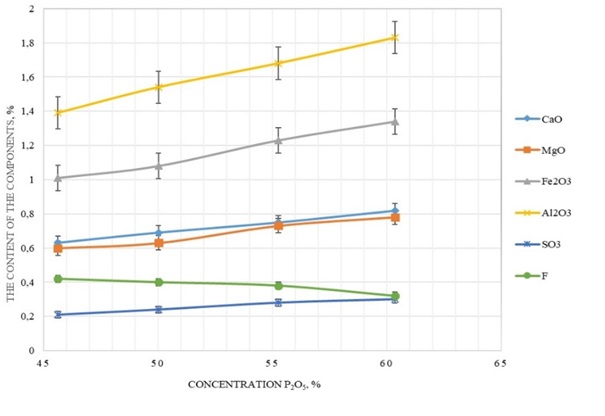Investigation of Vapor Pressure and Infrared Spectroscopic Analysis of Phosphoric Acid Extract Evaporation after Desulfation with SrCO₃
DOI:
https://doi.org/10.31489/2959-0663/4-24-4Keywords:
phosphorus, wet process phosphoric acid (WPA), Central Kyzylkums, ammophos, superphosphate, fertilizers, feed phosphates, IR spectroscopyAbstract
Ammophos-Maxam JSC is renowned for the production highly concentrated phosphorus fertilizers such as ammophos, ammonium sulfate phosphate, and suprephos, using thermally concentrated phosphorites sourced from the Central Kyzylkums. The production process heavily relies on wet-process phosphoric acid (WPA), which typically contains 16–18 % phosphorus pentoxide (P2O5). However, converting low P2O5 WPA into these high-phosphorus fertilizers during the stages of evaporation, drying, and granulation stages significantly increases the heat and energy consumption per unit of the final product. To address these challenges, extensive initiatives are currently underway in the republic. These efforts are aimed at improving the production of various phosphorus fertilizers, including ammophos, suprephos-NS, ammonium sulfate phosphate, PS-Agro, enriched superphosphate, and feed ammonium phosphates. These products are derived from the processing of washed burnt phosphoconcentrate (WBP-26) obtained from Kyzylkum phosphorites. This paper describes the results of recent studies on the evaporation process of WPA at Ammophos-Maxam JSC. The research focuses on examining the boiling point of WPA solutions, vapor pressure, and the composition of the resulting precipitates. Additionally, infrared (IR) spectroscopy was conducted to provide deeper insights into the material properties. These investigations are crucial for optimizing production processes and reduce energy costs.

Downloads
Published
How to Cite
Issue
Section
License
Copyright (c) 2024 Ilkhom Е. Khoshimov, Shakhzoda I. Turdialieva, Atanazar R. Seytnazarov, Shafaat S. Namazov, Mohamed A.L. Rifky

This work is licensed under a Creative Commons Attribution-NonCommercial-NoDerivatives 4.0 International License.
This work is licensed under a Creative Commons Attribution-NonCommercial-NoDerivatives 4.0 International License.
Authors retain copyright and grant the journal right of first publication with the work simultaneously licensed under a Creative Commons Attribution License (CC BY-NC-ND 4.0) that allows others to share the work with an acknowledgement of the work's authorship and initial publication in this journal.



